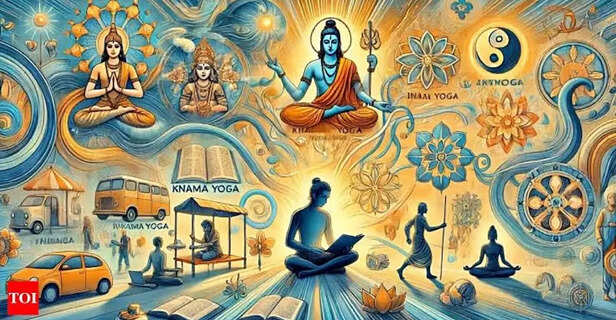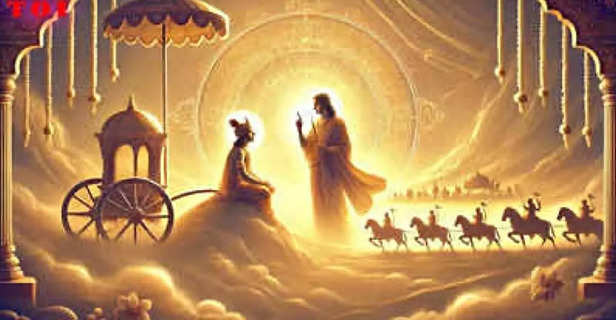Bhagavad Gita’s Most Scientific Verse—Check This Out!
Yuvraj Nanda | Mar 18, 2025, 23:23 IST
The popular scene of the Kurukshetra war, reimagined in AI.
The Bhagavad Gita is not a text that is entirely just spiritual—it’s deeply scientific! Discover the most profound verse aligning with modern science, explaining consciousness, energy, and the universe’s fundamental nature. From quantum physics to neuroscience, this ancient wisdom continues to amaze scientists today. Dive into the verse that bridges ancient philosophy with cutting-edge discoveries!
The Bhagavad Gita—potentially the most discussed and influential text of the Hindus around the world. The Gita is often seen as a spiritual and philosophical text, but how many of us know that it also contains wisdom that can be connected with a scientific perspective? Many of its verses align with interpretations that can be linked with physics, neuroscience, and consciousness studies.
One verse, in particular, stands out for its deep scientific significance—Bhagavad Gita 2.16:
“nāśato vidyate bhāvo, nābhāvo vidyate sataḥ |
ubhayorapi dṛṣṭo’ntastvanayostattva-darśibhiḥ ||”
(BG 2.16)
![A depiction of Hindu religion based art.]()
This verse translates to:
“That which is unreal (temporary) has no existence, and that which is real (eternal) never ceases to exist. The seers of truth have concluded this by studying the nature of both.”
Sounds philosophical? Let’s break it down scientifically!
![A depiction of Gita.]()
The given verse suggests that real things (eternal elements) never cease to exist, which aligns with the law of conservation of energy in physics. Energy can neither be created nor destroyed—only transformed. The Bhagavad Gita essentially might have hinted at this universal law based on multiple interpretations and sense of existential philosophy that persisted at that time. While science has evolved much more over the years, it is healthy to appreciate such a concept explained by a religious text from so many years ago.
![A statue of Arjuna and Krishna]()
Quantum mechanics is something that states that reality is not absolute—matter is made of energy, and its existence depends on observation. The verse here differentiates between temporary (illusory) and eternal (real) things, much like quantum physics differentiates between the transient material world and the fundamental energy underlying everything.
![The classic Gita art]()
Modern neuroscience uses multiple dimensions and techniques to explain consciousness, but the Bhagavad Gita metaphorically, and poetically suggests that the soul (consciousness) is eternal, beyond the body. This idea of Krishna’s oration very sharply resonates with cutting-edge theories of today which claim that consciousness, as a phenomenon may not be just a byproduct of the brain but something deeper and independent—an idea that might as well make one think that there are theories and realities that the human brain might not even be able to comprehend, as of today.
The society today—precisely ours definitely needs a healthier relationship between proven science and spirituality. While proven facts should always be taken into the highest regard and utmost respect, spiritual knowledge and the art of seeking is a way to find your own self. This verse of the Gita is what beautifully merges science and spirituality, reminding us of the oneness of the universe. This verse reminds us that adapting qualities from both the sects could lead to living a very happy life. Whether you’re a scientist, philosopher, or spiritual seeker, Bhagavad Gita 2.16 proves that truth is timeless!
So, what do you think—was Krishna the first scientist of the universe? Seek and interpret yourself.
Explore the latest trends and tips in Health & Fitness, Travel, Life Hacks, Fashion & Beauty, and Relationships at Times Life.
One verse, in particular, stands out for its deep scientific significance—Bhagavad Gita 2.16:
“nāśato vidyate bhāvo, nābhāvo vidyate sataḥ |
ubhayorapi dṛṣṭo’ntastvanayostattva-darśibhiḥ ||”
(BG 2.16)
Decoding the Science in This Verse

A depiction of Hindu religion based art.
This verse translates to:
“That which is unreal (temporary) has no existence, and that which is real (eternal) never ceases to exist. The seers of truth have concluded this by studying the nature of both.”
Sounds philosophical? Let’s break it down scientifically!
The Law of Conservation of Energy

A depiction of Gita.
The given verse suggests that real things (eternal elements) never cease to exist, which aligns with the law of conservation of energy in physics. Energy can neither be created nor destroyed—only transformed. The Bhagavad Gita essentially might have hinted at this universal law based on multiple interpretations and sense of existential philosophy that persisted at that time. While science has evolved much more over the years, it is healthy to appreciate such a concept explained by a religious text from so many years ago.
Quantum Physics and Reality

A statue of Arjuna and Krishna
Quantum mechanics is something that states that reality is not absolute—matter is made of energy, and its existence depends on observation. The verse here differentiates between temporary (illusory) and eternal (real) things, much like quantum physics differentiates between the transient material world and the fundamental energy underlying everything.
Consciousness Beyond the Physical Body

The classic Gita art
Modern neuroscience uses multiple dimensions and techniques to explain consciousness, but the Bhagavad Gita metaphorically, and poetically suggests that the soul (consciousness) is eternal, beyond the body. This idea of Krishna’s oration very sharply resonates with cutting-edge theories of today which claim that consciousness, as a phenomenon may not be just a byproduct of the brain but something deeper and independent—an idea that might as well make one think that there are theories and realities that the human brain might not even be able to comprehend, as of today.
Why This Verse Matters Today
So, what do you think—was Krishna the first scientist of the universe? Seek and interpret yourself.
Explore the latest trends and tips in Health & Fitness, Travel, Life Hacks, Fashion & Beauty, and Relationships at Times Life.
